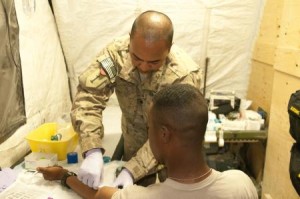Pathologists and blood bankers in many hospitals are finding it easier to manage costs because, for a variety of reasons, utilization of blood and blood products has declined in recent years
Demand for blood products is declining across the nation. This is a positive trend for pathologists and clinical laboratory professionals who manage blood banks in hospitals and health systems throughout the United States.
In recent decades, blood banks regularly worried about blood shortages, particularly in light of the aging population. However, a host of new medical technologies and clinical advances has dramatically reduced the utilization of blood products.
New Clinical Practices Are Reducing the Use of Blood
New technologies that limit surgical bleeding, improved blood management programs at hospitals, fewer elective surgeries due to the slow economy, along with higher insurance deductibles are each factors contributing to the decreasing demand for blood, reported an Associated Press (AP) story published by Evansville, Indiana’s courierpress.com.
Consequently, the nation’s blood collection system is undergoing a radical shift, with more targeted, but fewer appeals for blood donations and downsizing of operations.
Newer Surgical Methods and Blood Management Limit Blood Loss
Demand for blood has continued to drop. It declined by 8.2% between 2008 and 2011, reported AABB (formerly known as American Association of Blood Banks). Newer surgical methods, such as laparoscopic techniques that involve tiny incisions and little blood loss, have curbed blood demand.
Additionally, a growing number of hospitals are implementing more sophisticated blood management programs. These programs include collecting blood lost during surgery and returning it to the patient, maximizing hemoglobin levels to prevent anemia, and using medications to reduce bleeding during surgery.
Consequently, blood centers have changed “from a collect-as-much-as-you-can mentality to a collect-what-you-need mentality,” observed Pathologist Darrell J. Triulzi, M.D., Medical Director for the Institute for Transfusion Medicine in Pittsburgh and former President of AABB. He was quoted in the AP/courierpress.com article. “They started collecting only what they needed. That’s new to the industry. We’re still learning how to that well,” he added.

Pathologist Darrell J. Triulzi, M.D. (pictured), Medical Director for the Institute for Transfusion Medicine in Pittsburgh and former President of AABB, says that declining demand for blood is moving blood centers from “a collect-as-much-as-you-can mentality to a collect-what-you-need mentality.” (Photo copyright Institute for Transfusion Medicine.)
Blood centers, therefore, are downsizing operations and eliminating jobs. For example, in June 2013, the Indiana Blood Center announced a restructuring effort that would eliminate 45 positions, including mobile blood donor jobs. In explaining the restructuring and layoffs, Center officials cited a 24% decline in blood demand by hospitals over the previous year.
Declining Blood Demand Simply Means Fewer Critical Blood Shortages
While there are fewer appeals for blood donations, that doesn’t mean there’s a blood surplus, just fewer blood shortage crises requiring desperate pleas for donations, noted the AP/courierpress.com report. In fact, last summer, the Indiana Blood center experienced a critical shortage of blood. One reason this shortage occurred is because the Center gets 30% of its blood donations from high school and college students and donations by students decline during the summer months when they are on vacation, noted Dan Waxman, M.D., the Center’s Executive Vice President and Chief Medical Officer.
Because of the declining demand for blood products, blood centers also are targeting donations of specific blood types, particularly Type O Negative−the universal donor. Only 7% of the population has Type O Negative, but it comprises 13% of blood used by the Indiana Blood Center, “so we have to over-collect that blood group,” said Waxman.
To entice people with targeted blood types to donate blood, some collection centers are offering them incentives. In August, the South Bend Medical Foundation in Mishawaka used a flashing roadside message board to offer gift cards worth $10 to encourage passing motorists with Type O to donate blood.
Because whole blood transfusions are increasingly being replaced by blood component therapy, there is strong demand for platelets and Type AB plasma. These blood products are used for trauma patients, burn victims, and cancer patients. Red blood cells are needed for accident and gunshot victims, as well as in elective surgeries.
Military’s ‘Walking Blood Bank’ has Civilian Applications
What continues as an urgent need for blood transfusions are medical crises that result from military operations or natural disasters, such as hurricanes, earthquakes, tsunamis, tornadoes, floods, and fires.

U.S. Army Spc. John Eric Lawrence Macam, left, with Charlie Company, 201st Brigade Support Battalion, 3rd Brigade Combat Team, 1st Infantry Division draws blood from a donor during the walking blood bank at Forward Operating Base Apache in Zabul province, Afghanistan, June 21, 2013. The walking blood bank is designed to supply deployed soldiers who may be in need of blood with the best possible donor. (U.S. Army photo by Sgt. Michael Needham/Released.)
The Navy’s Forward Surgical Team (FST) has developed the “Walking Blood Bank” program, which was first implemented in Afghanistan. This is a way to provide an immediate, on-the-spot, alternative blood supply for injured soldiers. The program, however, could also be quickly launched in communities struck by natural disasters to supplement blood supply when local blood banks are overwhelmed.
The FST stores red blood cells and plasma, but no platelets due to its short shelf life. Blood storage capacity is limited, so specific blood types may be used up before helicopters land to replenish blood supply, noted a Sand Docs blog.
The Walking Blood Bank works like this. Service members willing to give blood are screened in advance. Should a patient need blood, the care team will activate the walking blood bank. On the base, a loudspeaker announcement calls for donors who share the patient’s blood type to report to the regiment’s medical company. Because some patients may need as much as 10 units, blood is collected from all of the volunteers. These donated units are then taken to the FST operating room and transfused immediately into the patient.
Useful Insights for Hospital Blood Bank Managers
Since hospital medical laboratories generally house in-hospital blood banks and are responsible for collecting blood and implementing blood management programs, clinical laboratory managers may want to learn about targeted blood collection programs and blood management strategies launched by other hospitals.
More inspiration for coordinating blood collection and distribution can be accessed by reading articles discussing the Navy’s Walking Blood Bank. One source of these stories is the Southern Medical Journal and Disaster Management Response. This program should be of particular interest to blood bank coordinators working in regions frequently hit by natural disasters, such as hurricanes and tornadoes.
—by Patricia Kirk
Related Information:
As demand dwindles, blood banks make big changes
Walking donor transfusion in a far forward environment
The walking blood bank: an alternative blood supply in military mass casualties




The fallacy of this article is that blood isn’t collected and donated instantly. It still has to be processed and screened. That takes hours. So, as good as the article sounds, blood is not immediately available to go from the donor to the recipient. In a true emergency, the program won’t work.